Do Billboard Ads Still Work in 2021?
Let’s rewind the clock 65 years to 1955. People got their news and information through three primary sources: television, radio, and newspapers. The interstate highway was a year away from being born, and this would not only help people travel between states easier but prove to be a valuable asset for brands, which would put billboards along the roads. Mail was widely used, and customers were used to receiving catalogs from Sears, among other brands. Cell phones, let alone smartphones, were decades away, so how companies reached consumers and entered their consideration sets was more deliberate.
Today, the landscape looks much different.
A large majority of the population has a smartphone – 84% according to Business Insider. Brands take advantage of organic posting and paid advertising, both online and on social channels. People can even receive push notifications from brands reminding them to take action. Marketing looks much different now than it does then.
But does that mean there isn’t a place for the channels that used to dominate? Are they still effective today? In this article, I’ll look at a few of those older advertising methods and see if there’s evidence they are – or aren’t – still effective today.
Are Billboards Still Impactful?
Billboards used to be a hugely important channel for brands. Before the days of a widely available internet, billboards were a great way to reach consumers, especially those that spent a significant amount of time in their cars commuting each day.
As it would turn out, we still do drive a lot. According to Dash Two, the average person spends about 194 minutes in a car each day. And when we do drive, we absolutely notice billboards. Dash Two notes that 71% of people consciously look at a billboard while driving. While that’s a scary thought, given that our eyes should be on the road, it’s clear billboards still attract attention.
They also attract ROI: for every $1 spent on billboard advertising, $5.97 is generated in sales.
If you’re curious about the top of funnel metrics, billboards impact those as well. According to a survey by Neilsen in 2017, 23% of people went online to find more information about a brand they saw on a billboard. Another 16% went to the website of the brand directly following an interaction with a billboard.
Given this, it’s easy to see why brands still spend money on billboards. According to Business Insider, over $6 billion was spent on billboard (referred to as “out of home” advertising) advertising in 2020, a figure that is projected to grow.
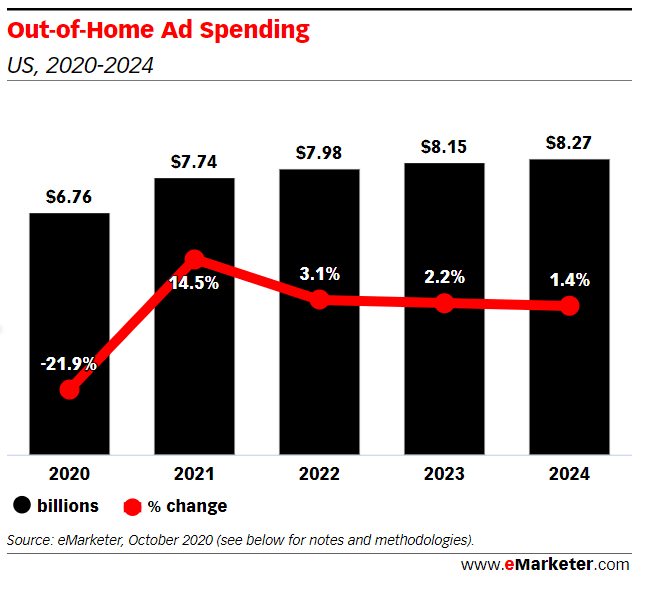
Along the same lines, the number of digital billboards in the United States has been rising over the last few years.
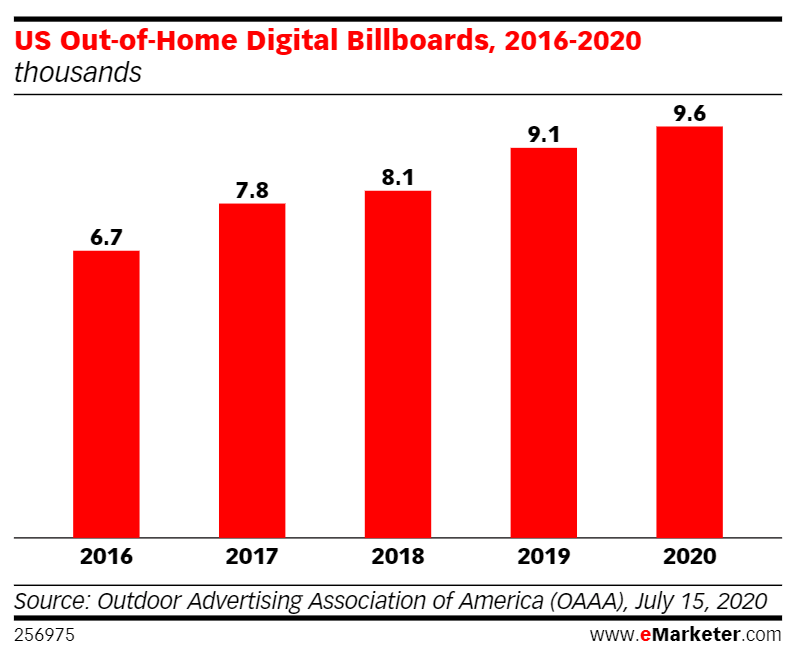
One wild card that could impact this moving forward is the changes in work brought on by the coronavirus pandemic. Specifically, many companies implemented telecommuting practices to comply with stay at home orders and keep their employees safe. Accordingly, fewer people were on the road this year.
While it’s too soon to say what trends will stick, I’m skeptical this means the end of billboards as we know them. For one, there are large swaths of the workforce – such as restaurant workers, healthcare providers, first responders, and grocery store workers – for whom telecommuting is not an option. They’ll still need to drive or take public transportation to their place of work, meaning they’ll be exposed to billboards while in their car or on the subway (remember, billboards aren’t just along highways – they can be in subways or park benches too).
Secondly, my hunch is that when this is over, and we have achieved herd immunity via a vaccine (or as close to it as we can), people will want to travel and get out of their houses.
2020 has been a long year for many people, and those who are able will likely take a vacation somewhere in 2021, if for no other reason than to not stare at the same four walls every day. That means more people in planes and cars as they get to their vacation destination of choice, meaning more visibility for billboards. There’s some evidence to the contrary that could make this prediction wrong, but something to monitor as the months pass, and we hopefully put the pandemic in the rearview.
How Relevant is Radio Advertising?
The short answer – alive and well. But things are a little more nuanced than that.
Let’s start by looking at what we consider traditional radio. As we saw earlier, people still spend a significant portion of their day in cars, which means many people listen to the radio. In fact, according to a 2018 Nielsen survey, radio reaches over 92% of all groups 18 years of age or older. No other channel can make that claim.
Accordingly, radio is the channel responsible for the largest reach among U.S. users.
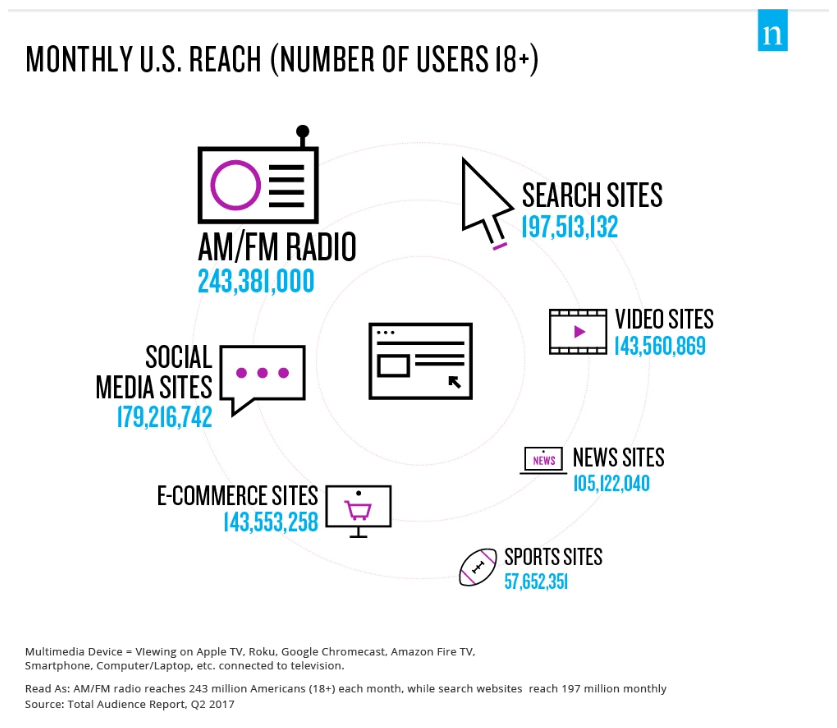
Advertisers still pour money into radio ads in the U.S. An estimated $10.7 billion was spent on radio advertising in 2020, according to Business Insider. That figure is expected to rise to $12.42 billion in 2021. This information was compiled in October of 2020, so the pandemic’s effects are factored in here.
Are radio ads, if done right, effective? They may be. According to Ads For Carts, 25% of Americans get more interested in brands after hearing a radio ad about them. Nielsen took things a step further and conducted a study into the topic. They found that, on average, a dollar spent on radio advertising returned $6 to brands. This evidence suggests that radio advertising is still an effective channel for many brands.
But is it more effective than digital radio? Spotify, Pandora, and podcasts are frequently tuned into on morning commutes, long road trips, and when someone just wants to unwind. It seems like, since digital is so pervasive in our lives, particularly during a pandemic, that it would be the more effective channel for marketers to pour their dollars into.
Not so fast. Check out the ad spending on digital radio, according to Business Insider.
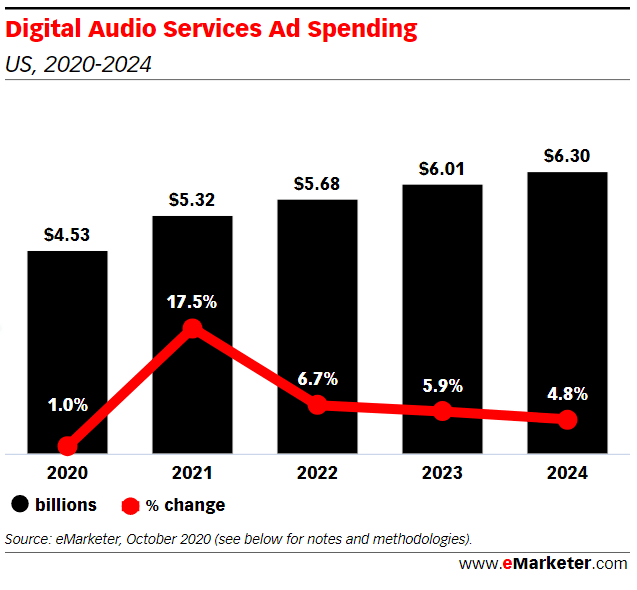
For all the bells and whistles surrounding digital music, the ad revenues haven’t caught up to over-the-air radio, at least not yet. Users also listen to traditional radio more. They spend 95 minutes a day with traditional radio, compared to about 82 minutes a day with digital.
The takeaways: traditional radio advertising isn’t dead, but digital still has some catching up to do.
How Effective is Newspaper and Magazine Advertising?
This is one that, before I started writing this article, I assumed had mostly been read its last rites. I know many newspapers and magazines have gone under over the years as the news cycle becomes more immediate – meaning we can use our phones to get news and analysis on what is happening, as it is happening. It’s so immediate that we even learn of high profile firings through Twitter.
Given all that, I went into this article thinking newspaper advertising was a dying medium. To a certain extent, that’s correct. Check out the anticipated spending trends in newspaper advertising, per Business Insider:
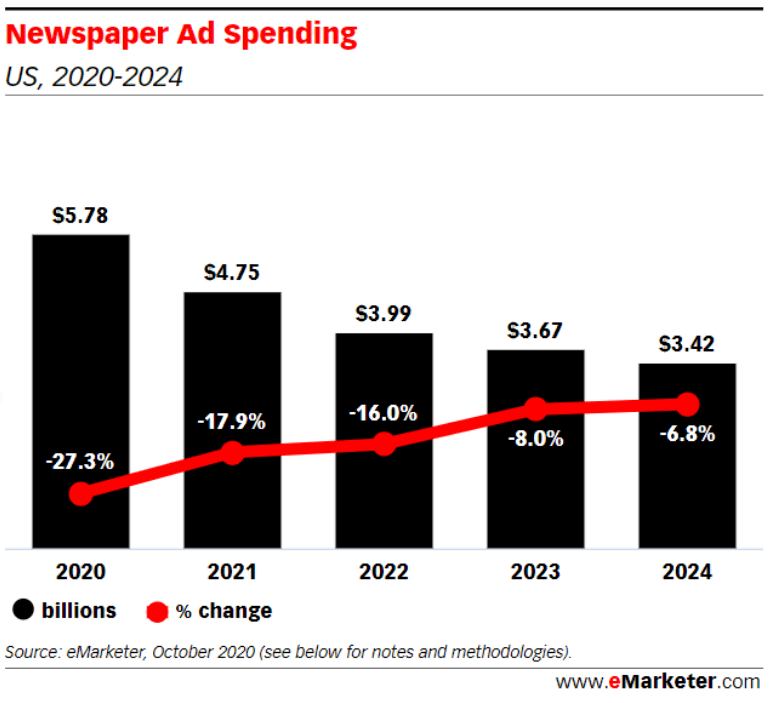
Notice that downward trend? That’s something that isn’t present in out of home or radio advertising. Beyond newspapers closing down, there’s another reason for this: Americans are losing trust in the media. According to Gallup, six in ten Americans have not very much trust or less in the media to report the news fully, accurately, and fairly. You can certainly debate the impact that cable news, hardening partisan beliefs, and Donald Trump being President have had on that, but newspapers are absolutely a part of that picture.
Magazines don’t fare much better: brands spent $5.81 billion on advertisements in 2020, but by 2024 that figure is expected to drop to $3.98 billion per Business Insider. This refers to print advertising. Digital is a slightly different story ($4.35 billion in 2020), though little growth is expected over time ($4.58 billion estimated in 2024).
Is there good news? There is – these ads may be effective. According to surveys compiled by Mansi Media, of those who were exposed to newspaper ads:
- 91% took action after looking at an insert
- 82% use the print coupons they find in newspapers
- 79% took action as a result of reading a newspaper
Let’s dig into the coupon stat briefly. As you know, marketers use coupons as a good way to influence purchases and encourage trials, particularly in the CPG industry. Print newspapers are still a great way to get those in the hands of potential customers. This highlights the importance of knowing your audience, where they are, and how to reach them. With coupons, you’re looking for people that may be elastic to price – that’s why they hunt down coupons after all. So being able to segment your audience and understand how to reach them properly is critical.
Generally speaking, though? Newspaper advertising is a decaying channel.
With more and more people spending more and more time online – particularly during the pandemic – and the fact that many newspapers have either switched to digital or gone under completely, this is one I would be cautious about using as a channel. If I were going to use it, I’d make sure I knew I could reach my target audience using that as a channel. According to Nielsen, Baby Boomers comprise the largest segment of print newspaper readers, so if that’s your audience, this may be a channel for your brand. But like every other channel, know that going in.
At the End of the Day: Know Your Target Market
To sum it up, even though we live in a digital world, there’s still a place for most traditional advertising. Analyze who your customers are, understand where they are, and advertise accordingly. Don’t just focus on what comes up on a computer or smartphone. Consider other channels as well, and if you do it right, you’ll be bringing in money for your business.
